Implementation of Cognitive Digital Twins in Connected and Agile Supply Networks—An Operational Model
Abstract
1. Introduction
2. Methodological and Operational Framework for CDTs
- Inadequate understanding of the connotations of CDT-driven manufacturing.
- Focus mostly on operation and maintenance of production lines and not on the value chain.
- Lack of application frameworks and reference models for CDTs [17].
- (1)
- Understanding the concept and functionality of a CDT.
- (2)
- Positioning the CDT into the manufacturing context and more particular in reference Industry 4.0 architectures using some reference scenarios.
- (3)
- Define the basic enablers for a CDT and explaining how they apply in the reference scenarios.
2.1. Understanding CDTs
- Create and manage a virtual model of the system.
- Virtualize the behaviour of the physical entity.
- Have different capabilities allowing to simulate, predict and optimize.
- Connect virtual (model) entities with physical ones, updating itself in response to known changes to the entity’s state condition or context.
- The Predictable Desired (PD), which is the desired (normal) behaviour of the system.
- The Predictable Undesired (PU), which are problems that are expected but we cannot understand why they happen.
- The Unpredictable Desired (UP), which is the “surprise” and benefits/good behaviour of the system that we did not expect to happen.
- The Unpredictable Undesired (UU), which is a serious fact and relates to behaviour that we did not expect to happen, and we do not know why they happen.
2.2. CDTs Positioning in the Supply Chain
- There is an up-to-date representation of the operational behaviour, which is fed by streamed data from sensing devices or other supporting measurement systems.
- All possible interactions with other production assets are known thus creating a virtual representation of the factory/supply chain as a dynamic system.
- Combining the behaviour and the networking of such asset we can monitor, simulate and optimize its performance.
2.3. Enablers for CDTs in Agile Supply Chains
2.3.1. Profile
2.3.2. Cognition
- Reasoning services, which are responsible for understanding a context and generating new knowledge-based on existing domain knowledge, past data, data streams from the physical entity, and insights obtained from simulation and prediction services, or optimization models and services.
- Simulation and Prediction Services that propagate a DT’s behaviour in the future to understand which future scenarios are most likely to happen and provide insight into whether an undesired outcome is about to take place. Prediction services can be used to learn from past anomalies and predict if new observed values are considered anomalous.
- Optimization models and services, which allow finding valid and, in many cases, near-optimal solutions, given a set of constraints.
2.3.3. Lifecycle
- Creation, where the profile of a DT is defined. Different configurations are assessed and—using data streams—“asset’s” behaviour model is identified. This is achieved through experimentations/simulations and removing unpredicted and undesirable behaviours.
- Production, where interfaces and created between the DT and physical asset and are ready to communicate each other.
- Operation, where information between physical asset and DT is exchanged. There any change in the physical asset (e.g., parts replacement) updates the DT model and further information coming from the DT can predict anomalies or changes in the physical asset’s behaviour. In principle, the operation is a continuous alignment of the physical and virtual operation.
- Disposal or recycling. At the final stage, the full operation of a DT is considered as source of learning to avoid future mistakes in next modelled production systems.
- Very short (creating and operating only in the planning phase: just examining whether to collaborate with a producer).
- Time-limited in the case of a collaboration but in specific timeframe (e.g., only for a particular and seasonal batch of products).
- Longer and lasting, in a case of more permanent collaboration with the producer.
2.3.4. Computation
2.3.5. Communication
- A production line: Network of interconnected machine CDTs.
- A factory: Network of interconnected operational entities that illustrate the main manufacturing operations in the entire value chain.
- A supply chain network: A supply chain network will be a network of interconnected CDTs each one representing the entities participating in the whole network (factories, suppliers, customers, warehouses, etc.).
2.3.6. Visualizations
2.3.7. Trustworthiness
- The right information is generated with respect to factory CDT’s sharing policies. This means that the factory CDT will send only the necessary information in the supply network without disclosing anything that is marked as “confidential”.
- Such information is sent and can be used only by the authorized CDTs. This is done by enforcing access control policies in the network and applying the rules of collaboration and governance aspects (which are detailed in the next section).
- Such data is actively monitored to ensure its integrity and detect potential data poisoning, that could disrupt machine learning models training, and their outcomes.
- Any action from the CDTs on the information shared can be traced, thus providing transparency of use in the whole supply chain and ensuring trust among the collaborators.
- The information is accurate and values the rest stakeholders by updating their production schedules and other internal operations.
2.3.8. Governance
- who has a voice in decision making?
- how are decisions made?
- Who is accountable?
- Data sovereignty and governance: Introduced by the Industrial Data Space [34], this refers to the rules of data management (ownership, terms of conditions and use).
- Prioritization of criteria in a context of decision-making (optimization): Imagine a 3d-printing-as-a-service company, which gets an order from a “big customer”. In the decision on the delivery date (by combining other orders and reschedule its production plan), if there is a strict service level agreement (SLA) of 24h delivery for the customer, this changes the priorities and gives a higher level of important to this particular order.
- Legislation/Regulation: Let us assume the case of materials logistics using drones or other autonomous vehicles (according to McKinsey [35], semi- autonomous delivery is expected to be a trend from the near terms in the beginning of the 2020–2030 decade). In such a case, there are specific regulations (with regards where to fly, etc.), which must be modelled and enforced in the operation of the CDTs. Such rules are very important and special attention has to be given to avoid liability issues.
- Reputation and past-experience knowledge: considering again the case of a contractor manufacturer (3D printing), the past-experience creates knowledge and some predicted rules of collaboration behaviour. If the manufacturer’s supplier has not proved trustworthy in the terms (e.g., delivery dates) then the 3D printing company faces some risks in delivering the product according to the SLA. Reputation mechanisms and records from previous transactions can form those rules to be considered in the decision-making process.
Liability and Compliance with Legislation/Regulation and Ethics
The Need for a Code of Fair Operation
CDT Governance Approach
- Define the context of operation (in which factory/supply chain hierarchical structure does the CDT belong?)
- Identify relevant stakeholders, CDTs and needs (physical asset, other involved assets/CDTs): Include appropriate external stakeholders where needed (e.g., customers who give input on the design aspects of a product manufactured by a particular production line CDT).
- Define interactions among stakeholders/CDTs: Clearly identify inputs/outputs, information sources and needs.
- Define roles per stakeholder/CDT: Who does what? Which are the decision-making power and authorizations? Is a particular CDT able to autonomously make decisions and initiate actions?
- Agree on liability and legislation issues: Agree on the ownership and liability of any malfunction of the CDT. Define any applicable legislation rule that affects the operation of the CDT.
- Define rules of collaboration, such as: Who owns data? Which are the norms/rules of collaboration/information exchange/processing and decision making? Which are the applicable information authorizations (access control policies, etc.)?
- Define required AI models: Agree on valuable insights that can be provided by forecasting future outcomes based on past data, or anomalies learnt based on past data. Explanations should be served along with those insights, to understand models’ rationale behind a forecast or detected anomaly.
- Procedures/workflows: Given an information input and knowledge acquired (cognition) what is the process to be followed? How can cognition improve this process?
3. The Cognition Process: A Reference Operational Framework Model for CDTs
3.1. The Model
- Profiling: Define the knowledge about the CDT, assign relationships with other CDTs (parent-child) to create the structure of the network
- Visualization: Monitor the configuration phase and the different parameters/CDT characteristics.
- Lifecycle: Define status of the CDT, make ad-hoc or static CDTs, etc.
- Governance: Define governance and decision-making policies; rules of collaboration among CDTs.
- Communication: Communication capabilities of the CDT that defines the sources of the data streams (either from the physical assets and/or from other CDTs that represent different information sources).
- Computation: refers to basic calculations and transformations that happen either at the cloud and/or edge.
- Trustworthiness: refers to the applicable security/privacy/trust services and policies that apply in the process of collecting info from other physical asset/CDTs.
- Visualization: Data streams visualization.
- Lifecycle: Monitor status of the CDT (modelled in step #1).
- Governance: Apply governance policies.
- Cognition: Analytics based on existing behaviour models or data-driven knowledge extraction that updates the existing model.
- Computation: Refers to whether cognition services will run at the cloud and/or edge.
- Trustworthiness: Refers to the applicable security/privacy/trust services and policies that apply when processing info from other physical asset/CDTs.
- Visualization: Knowledge visualizations.
- Lifecycle: Monitor status of the CDT (modelled in step #1).
- Governance: Apply governance policies.
- Cognition: Simulation and prediction services propagating the system’s behaviour with the new knowledge in the near future and identify potential anomalies.
- Computation: Refers to whether cognition services will run at the cloud and/or edge.
- Trustworthiness: refers to the applicable security/privacy/trust services and policies that apply when processing info from other physical asset/CDTs.
- Visualization: Simulation and prediction visualizations.
- Lifecycle: Monitor status of the CDT (modelled in step #1).
- Governance: Apply governance policies.
- Cognition: Robust optimization services to identify new behaviour parameters. Simulation and prediction services propagating the new (proposed) system’s behaviour in the near future and identify potential anomalies.
- Computation: Refers to whether cognition services will run at the cloud and/or edge.
- Trustworthiness: Refers to the applicable security/privacy/trust services and policies that apply when processing info from other physical asset/CDTs.
- Visualization: Behaviour visualization.
- Lifecycle: Monitor status of the CDT (modelled in step #1).
- Governance: Apply governance policies.
- Communication: CDT with physical asset communication.
- Computation: Refers to whether services will run at the cloud and/or edge.
- Trustworthiness: Refers to the applicable security/privacy/trust services and policies that apply when actuation is performed from CDT to the physical asset.
- Visualization: Monitoring the status of the actuation (confirmed or not, other).
- Lifecycle: Monitor status of the CDT (modelled in step #1).
- Governance: Apply governance policies.
3.2. Deploying the CDT Operational Model in Connected Agile Supply Networks
3.2.1. Overall
- A dynamic, living system of “cognitive digital twins” representing all assets, operations and actors involved: factory, logistics service provider (LSP), trucks, warehouses, etc. Each entity participating in the supply chain can be modelled as a CDT. Deploying the enablers described above, each CDT can share only the necessary information with other CDTs and agree on governance aspects and rules applicable in all communications and decision-making process.
- Interconnected CDTs at intra- and inter-factory (supply chain) level. This implies the definition of the information/events to be shared under a common security/privacy and data integrity framework.
- Different levels of cognition. Depending on the level of autonomy (defined in the governance framework for each of the CDTs) different cognition capabilities will apply. Those will vary from basic understanding to autonomous decision making and actuation.
3.2.2. Deployment Methodology
Scope Definition
- What is the overall operational flow of my supply chain?
- Why is it critical to monitor the supply chain? We need to justify our focus with KPIs and other quantitative/qualitative metrics.
- Define the core stakeholders: Who are the ones that contribute most to the challenge/problem defined above? here we need to define our system boundaries (either we focus on a specific supplier tier or even select the most important in multiple tiers).
- Define and select the process where to focus: Depending on the challenge, we need to identify the critical process(es), which will be the focus for modelling and operation.
System Modelling
- Operational/process modelling: Create the process workflows and map the stakeholders, roles, inputs and outputs.
- Define the needs for CDTs: Depending on the challenge, the workflows we need to understand which asset/process or even entity in the supply chain has to be modelled as CDT. We might come with a 1-to-1 relationship between CDT and entity or a group of inter-connected CDTs.
- Elaborate on the CDT enablers: For each of the CDT identified, we need to understand how the enablers apply. This is a time-consuming issue since all actors have to agree on the information to be monitored, governance issues, cognition levels of autonomy per CDT and other parameters.
- Understand and model information needs: The focus is on the information to be exchanged/collected which will be further used in the analytics/cognition models.
- Deploy and train the necessary cognition/analytics models: Different strategies are required to train different types of models. To ensure the quality of the service exposing them, special attention must be put on monitoring concept drift, and models’ performance over time.
- Deploy the necessary optimization algorithms for decision making.
Design and Operation
Rollout
3.3. Application Areas—Reference Scenarios
3.3.1. Optimizing Material Flows in Circular Supply Chains
3.3.2. Virtual Supply Chain Production Lines
3.3.3. Optimize Material Flows in the Supply Chain
3.3.4. Localization: Ad-Hoc or Constant Collaborations with Local Manufacturers
4. Deploying the Model into Circular Supply Chain—The Case of Circular Supply Chain
4.1. The Case of Circular Supply Chain in Rural Areas
4.2. Operational Scenarios
4.2.1. Scenario #1: Informing about Feedstock Availability and Collection/Deposit Points
4.2.2. Scenario #2: Optimized Logistics Operations
- Predictions of feedstock availability based on experience and historical data: In such case, the LSP can organize better the collection points. Those can be for example, deposit bins or mobile processing units where possible and/or daily positioning the network of trucks in specific locations to respond quicker to a particular need.
- Optimal planning (or re-planning to satisfy the different requests): (re-) Planning can have the following forms: a) routing (finding the optimal route) or b) find the truck that (based on its location and existing route) can fulfil the particular order. Further to this, optimization will deal with the problem “Where to find the nearest actor to deposit my waste of someone to collect it”.
4.2.3. Scenario #3: Waste Incoming Handling from the Factory
4.3. Configuration/Modelling Phase (Step 1 in the Operational Model)
4.3.1. Stakeholders, Roles and Applicable CDTs
4.3.2. CDTs Liability, Collaboration and Governance
4.4. The Cognition Process (Steps 2, 3, 4, 5 and 6 in the Operational Model)
4.4.1. Collect Data Streams about the Behaviour of the CDT (Step #2 of the Operational Model)
4.4.2. Understand Context (Step #3 in the Operational Model)
4.4.3. Simulate and Prediction (Step #4 in the Operational Model)
4.4.4. Decisions (Optimization) (Step #5 of the Operational Model)
- Farmers to get a proposal about which is the optimal way to deposit the waste: either finding the nearest available bin/mobile processing unit or send a request to an LSP because a truck is nearby and is available to pick the waste.
- The nearest truck CDT gets a request about a waste to be collected. Given its existing route/collection plan, the CDT gets the request and processing it and decisions can be:
- -
- The CDT collects the plan with a new optimized delivery plan or
- -
- The CDT communicates with other truck CDTs and “negotiate” the collection from others.
- The RV gets a recommendation of the optimal way to deposit the waste: a nearby bin CDT or a truck CDT.
- The factory CDT gets optimal recommendations for production scheduling, material handling based on the real-time information and forecasts about the incoming materials.
- In a more strategic view, the LSP can organize better the collection points. Those can be for example: deposit bins or mobile processing units where possible) and/or position the network of trucks in specific locations to respond quicker to a particular need. Based on the supply chain behaviour of how waste is collected, how often and from which location, the LSP can assess different scenarios and find an optimal network that can satisfy ad-hoc requests and with the minimum respond time and cost.
4.4.5. Actuation (Step #6 in the Operational Model)
- Manual actuation from the user (driver, farmer, etc., which means no CDT actuation).
- Semi-manual actuation: the CDT gets the approval by the end user about what to do and the CDT performs the action.
- Automatic actuation: this can be for decisions that the CDT is able to perform and act.
5. Conclusions
Author Contributions
Funding
Institutional Review Board Statement
Informed Consent Statement
Data Availability Statement
Acknowledgments
Conflicts of Interest
References
- WMF. The 2020 World Manufacturing Report: Manufacturing in the Age of Artificial Intelligence. Available online: https://worldmanufacturing.org/wp-content/uploads/WorldManufacturingForum2020_Report.pdf (accessed on 13 February 2021).
- Pearson, H.; Noble, G.; Hawkins, J. Redistributed Manufacturing Workshop Report; EPSRC-Engineering and Physical Sciences Research Council, 2013; Available online: https://epsrc.ukri.org/newsevents/pubs/re-distributed-manufacturing-workshop-report/ (accessed on 13 February 2021).
- Deloitte. Business Ecosystems Come of Age. 2017. Available online: https://www2.deloitte.com/content/dam/insights/us/articles/platform-strategy-new-level-business-trends/DUP_1048-Business-ecosystems-come-of-age_MASTER_FINAL.pdf (accessed on 18 January 2021).
- EFFRA. Factories 4.0 and Beyond: Recommendations for the Work Programme 18-19-20 of the FoF PPP under Horizon 2020. 12 September 2016. Available online: https://www.effra.eu/sites/default/files/factories40_beyond_v31_public.pdf (accessed on 23 October 2020).
- ElMaraghy, H.; Schuh, G.; Piller, F.; Schönsleben, P.; Tseng, M.; Bernard, A. Product variety management. CIRP Ann. 2013, 62, 629–652. [Google Scholar] [CrossRef]
- Kiritsis, D. Closed-loop PLM for intelligent products in the era of the Internet of things. Comput. Des. 2011, 43, 479–501. [Google Scholar] [CrossRef]
- Schuh, G.; Rebentisch, E.; Dölle, C.; Mattern, C.; Volevach, G.; Menges, A. Defining Scaling Strategies for the Improvement of Agility Performance in Product Development Projects. Procedia CIRP 2018, 70, 29–34. [Google Scholar] [CrossRef]
- IDC. IDC Manufacturing Insights; IDC: Needham, MA, USA, 2014. [Google Scholar]
- McKinsey. Industry4.0: How to navigate digitization of the manufacturing sector, McKinsey Digital. 2015. Available online: https://www.mckinsey.com/business-functions/operations/our-insights/industry-four-point-o-how-to-navigae-the-digitization-of-the-manufacturing-sector (accessed on 1 October 2020).
- CGI. CGI Client Global Insights 2018 for Manufacturing, Summary. 2018. Available online: https://www.cgi.com/en/media/white-paper/manufacturing-client-global-insights-2018 (accessed on 2 February 2021).
- Grieves, M. Digital twin: Manufacturing excellence through virtual factory replication. White Paper 2014, 1, 1–7. [Google Scholar]
- Tao, F.; Qi, Q.; Wang, L.; Nee, A. Digital Twins and Cyber–Physical Systems toward Smart Manufacturing and Industry 4.0: Correlation and Comparison. Engineering 2019, 5, 653–661. [Google Scholar] [CrossRef]
- Gartner. Gartner Identifies the Top 10 Strategic Technology Trends for 2019. 2018. Available online: https://www.gartner.com/en/newsroom/press-releases/2018-10-15-gartner-identifies-the-top-10-strategic-technology-trends-for-2019 (accessed on 16 September 2020).
- Qi, Q.; Tao, F.; Zuo, Y.; Zhao, D. Digital Twin and Big Data Towards Smart Manufacturing and Industry 4.0: 360 Degree Comparison. IEEE Access 2018, 6, 3585–3593. [Google Scholar] [CrossRef]
- DIGICOR. DIGICOR H2020 Project: Decentralized Agile Coordination across Supply Chains; DIGICOR; Available online: https://www.digicor-project.eu/ (accessed on 12 November 2020).
- Heutger, M.; Kuechelhaus, M. Digital Twins in Logistics: A DHL Perspective on the Impact of Digital Twins in the Logistics Industry; DHL, 2019; Available online: https://www.dhl.com/content/dam/dhl/global/core/documents/pdf/glo-core-digital-twins-in-logistics.pdf (accessed on 12 December 2020).
- Rojas, R.A.; Rauch, E. From a literature review to a conceptual framework of enablers for smart manufacturing control. Int. J. Adv. Manuf. Technol. 2019, 104, 517–533. [Google Scholar] [CrossRef]
- Kritzinger, W.; Karner, M.; Traar, G.; Henjes, J.; Sihn, W. Digital Twin in manufacturing: A categorical literature review and classification. IFAC Papers OnLine 2018, 51, 1016–1022. [Google Scholar] [CrossRef]
- Minerva, R.; Lee, G.M.; Crespi, N. Digital Twin in the IoT Context: A Survey on Technical Features, Scenarios, and Architectural Models. Proc. IEEE 2020, 108, 1785–1824. [Google Scholar] [CrossRef]
- Grieves, M.; Vickers, J. Digital Twin: Mitigating Unpredictable, Undesirable Emergent Behavior in Complex Systems. In Transdisciplinary Perspectives on Complex Systems; Springer: Berlin, Germany, 2017; pp. 85–113. [Google Scholar]
- Rozanec, J.; Lu, J.; Rupnik, J.; Skrjanc, M.; Mladenic, D.; Fortuna, B.; Zheng, X.; Kiritsis, D. Actionable Cognitive Twins for Decision Making in Manufacturing. 23 March 2021. Available online: https://arxiv.org/pdf/2103.12854v1.pdf (accessed on 24 March 2021).
- Lu, J.; Zheng, X.; Gharaei, A.; Kalaboukas, K.; Kiritsis, D. Cognitive twins for supporting decision-makings of Internet of Things systems. In Proceedings of the 5th International Conference on the Industry 4.0 Model for Advanced Manufacturing, Belgrade, Serbia, 1–4 June 2020. [Google Scholar]
- P. Industrie4.0. RAMI4.0: A Reference Model for Digitalization. 9 August 2018. Available online: https://www.plattform-i40.de/PI40/Redaktion/EN/Downloads/Publikation/rami40-an-introduction.html (accessed on 24 November 2020).
- Cheng, J.; Zhang, H.; Tao, F.; Juang, C.-F. DT-II: Digital twin enhanced Industrial Internet reference framework towards smart manufacturing. Robot. Comput. Manuf. 2020, 62, 101881. [Google Scholar] [CrossRef]
- Qi, Q.; Tao, F.; Zuo, Y.; Zhao, D. Digital Twin Service towards Smart Manufacturing. Procedia CIRP 2018, 72, 237–242. [Google Scholar] [CrossRef]
- Tao, F.; Zhang, H.; Liu, A.; Nee, A.Y.C. Digital Twin in Industry: State-of-the-Art. IEEE Trans. Ind. Inform. 2019, 15, 2405–2415. [Google Scholar] [CrossRef]
- Lu, Y.; Liu, C.; Wang, K.I.-K.; Huang, H.; Xu, X. Digital Twin-driven smart manufacturing: Connotation, reference model, applications and research issues. Robot. Comput. Manuf. 2020, 61, 101837. [Google Scholar] [CrossRef]
- Ellis, S.; Hand, L.; Ortis, I.; The Future of the Supply Chain: Disrupt or to Be Disrupted. IDC Sponsored by Oracle. September 2018. Available online: https://www.oracle.com/a/ocom/docs/industries/idc-disrupt-or-be-disrupted-wp.pdf (accessed on 7 February 2021).
- Schützer, K.; Bertazzi, J.D.A.; Sallati, C.; Anderl, R.; Zancul, E. Contribution to the development of a Digital Twin based on product lifecycle to support the manufacturing process. Procedia CIRP 2019, 84, 82–87. [Google Scholar] [CrossRef]
- Kalaboukas, K.; Lioudakis, G.; Koukovini, M.; Papagiannakopoulou, E.; Morabito, G.; Dellas, N.; Zacharias, M.; Quattropani, S.; Samarotto, M.; Jermol, M.; et al. Cognitive Logistics Operations through Secure, Dynamic and ad-hoc Collaborative Networks: The COG-LO Project. In Proceedings of the 6th International Physical Internet Conference, 9–11 July 2019, London, UK.
- Suhail, R.; Hussain, R.; Jurdak, R.; Hong, C.S. Trustworthy Digital Twins in the Industrial Internet of Things with Blockchain. 2020. Available online: https://arxiv.org/abs/2010.12168 (accessed on 15 February 2021).
- Defining Governance (IoG). Available online: https://iog.ca/what-is-governance/ (accessed on 17 January 2021).
- Nochta, T.; Badstuber, N.; Wahby, N. On the Governance of City Digital Twins—Insights from the Cambridge Case Study; Centre for Digital Built Britain. 2019. Available online: https://doi.org/10.17863/CAM.41083 (accessed on 14 January 2021).
- Otto, B.; Jurgens, J.; Schon, J.; Auer, S.; Menz, N.; Wenzel, S.; Cirullies, J. Industrial Data Space: Digital Sovereingty over Data. 2016. Available online: https://www.fraunhofer.de/content/dam/zv/en/fields-of-research/industrial-data-space/whitepaper-industrial-data-space-eng.pdf (accessed on 6 February 2021).
- Schroder, J.; Held, B.; Neuhaus, F.; Kasser, M.; Klink, C.; Tatomir, S. Fast Forwarding Last-Mile Delivery—Implications for the ECOSYSTEM; McKinsey&Company, 2018; Available online: https://www.mckinsey.com/~/media/mckinsey/industries/travel%20logistics%20and%20infrastructure/our%20insights/technology%20delivered%20implications%20for%20cost%20customers%20and%20competition%20in%20the%20last%20mile%20ecosystem/fast-forwarding-last-mile-delivery-implications-for-the-ecosystem.pdf (accessed on 19 December 2020).
- Saracco, R. Available online: https://cmte.ieee.org/futuredirections/2020/07/17/the-economics-of-the-digital-transformation-xii/ (accessed on 17 July 2020).
- Joerss, M.; Neuhaus, F.; Schroder, J. How Customer Demands Are Reshaping Last-Mile Delivery; McKinsey&Company, 19 October 2016; Available online: https://www.mckinsey.com/industries/travel-logistics-and-infrastructure/our-insights/how-customer-demands-are-reshaping-last-mile-delivery# (accessed on 15 March 2021).
- Bonnefon, J.-F.; Shariff, A.; Rahwan, I. The social dilemma of autonomous vehicles. Science 2016, 352, 1573–1576. [Google Scholar] [CrossRef] [PubMed]
- Congress, L.L.-L.o. Supply Chain Regulation of Pharmaceutical Samples—European Union-Japan-Turkey. September 2019. Available online: https://www.loc.gov/law/help/pharmaceutical-samples/pharmaceutical-samples.pdf (accessed on 14 March 2021).
- Taisch, M.; Casidsid, G.; May, T.; Morin, V.; Padelli, M.; Pinzone; Wuest, T. World Manufacturing Report; World Manufacturing Forum: Cernobbio, Italy, 2020. [Google Scholar]
- Smart Specialization Platform. European Commission. Available online: http://s3platform.jrc.ec.europa.eu/ (accessed on 14 March 2021).
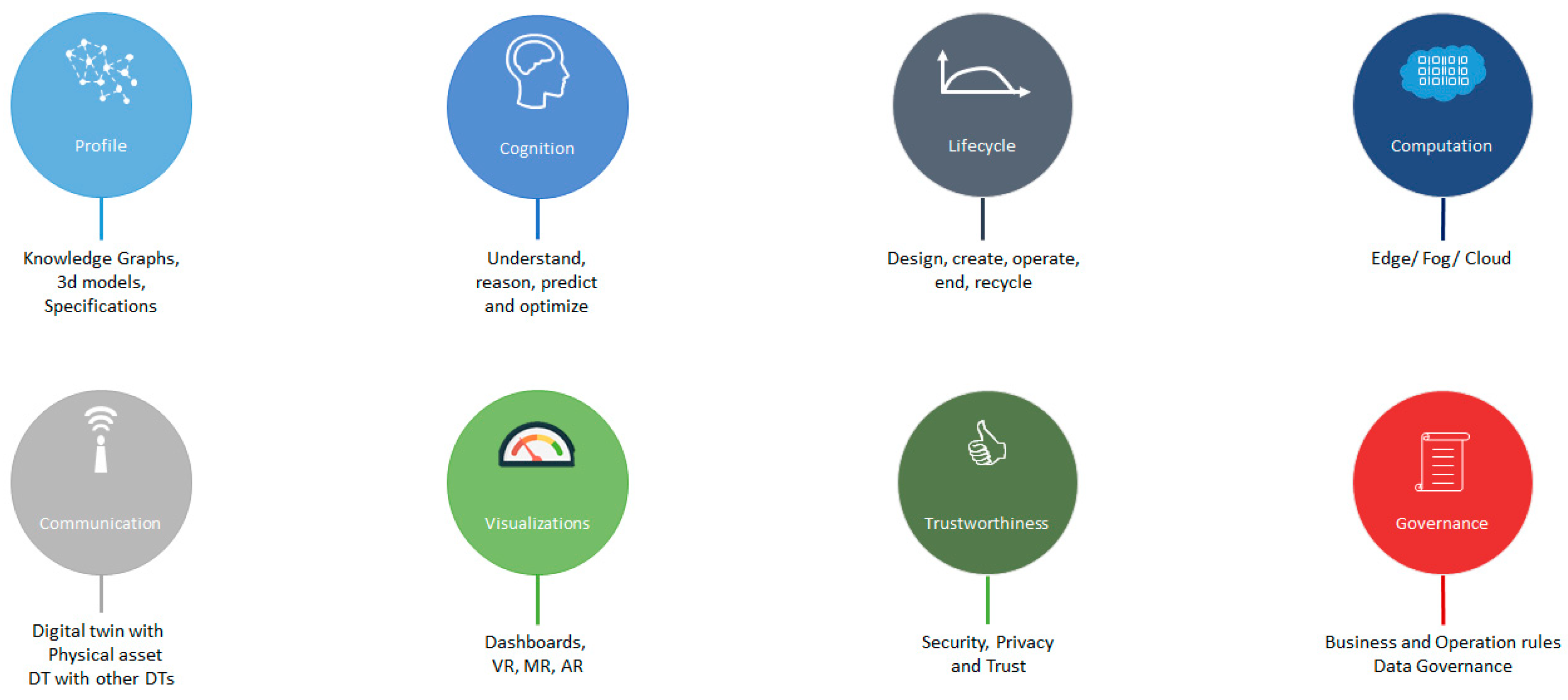
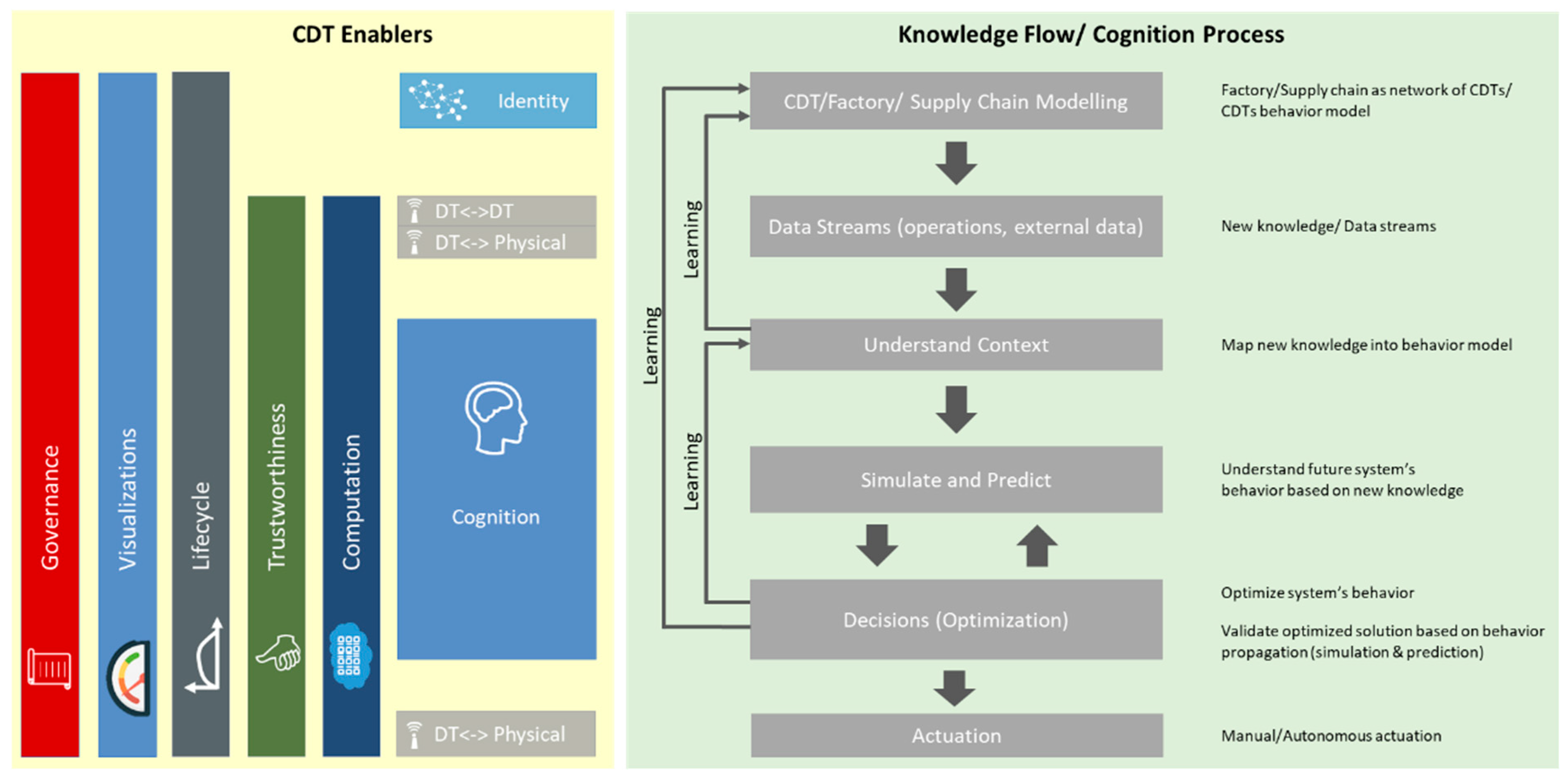
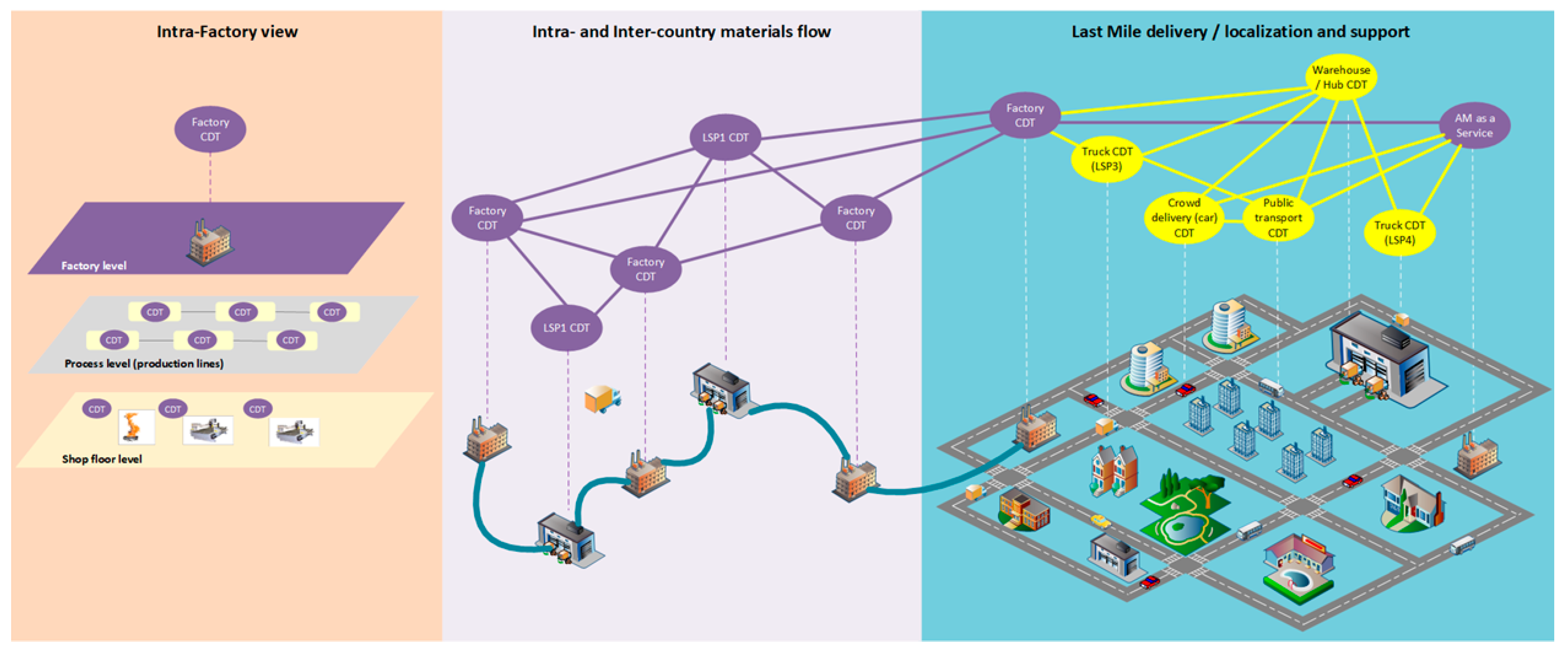
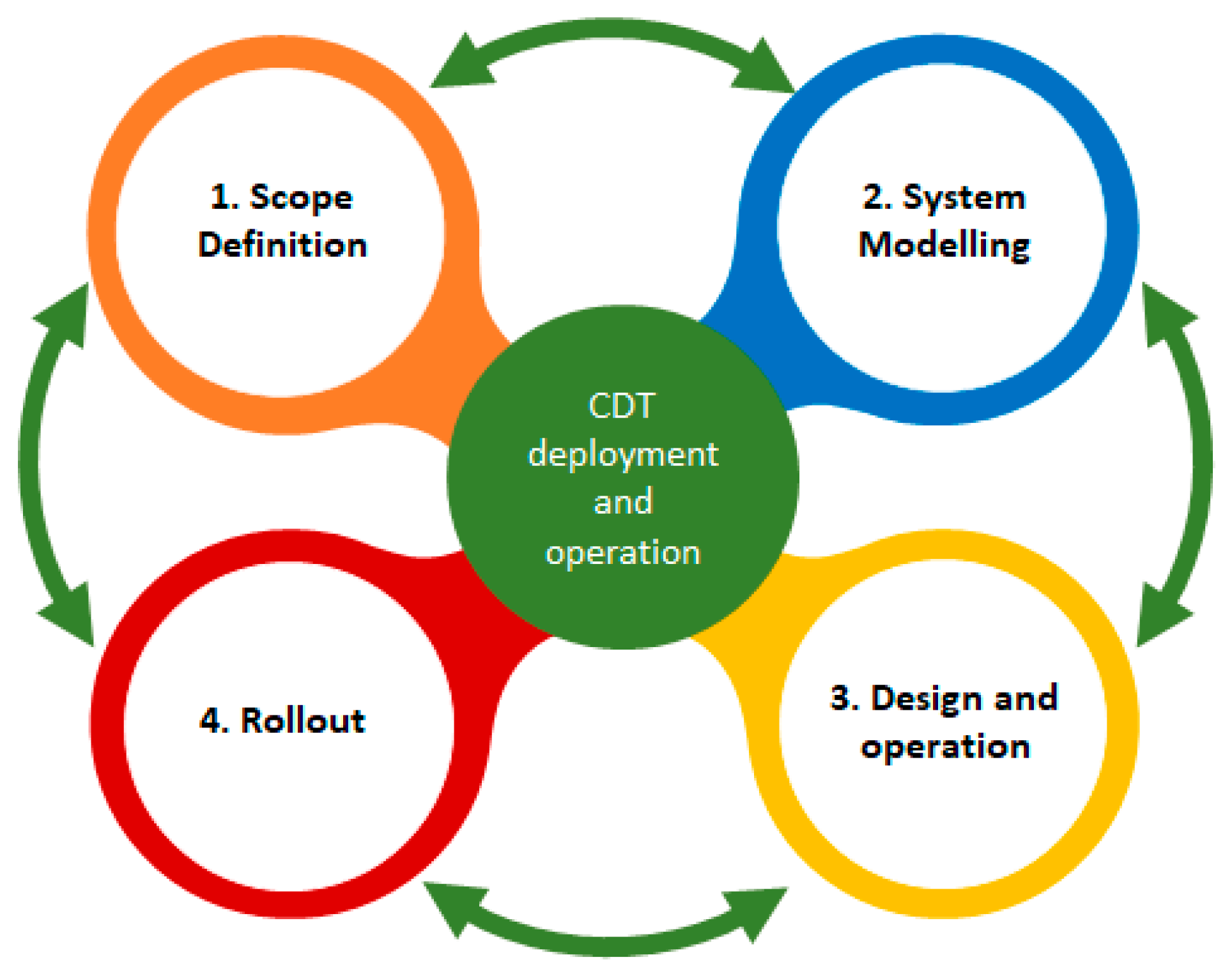
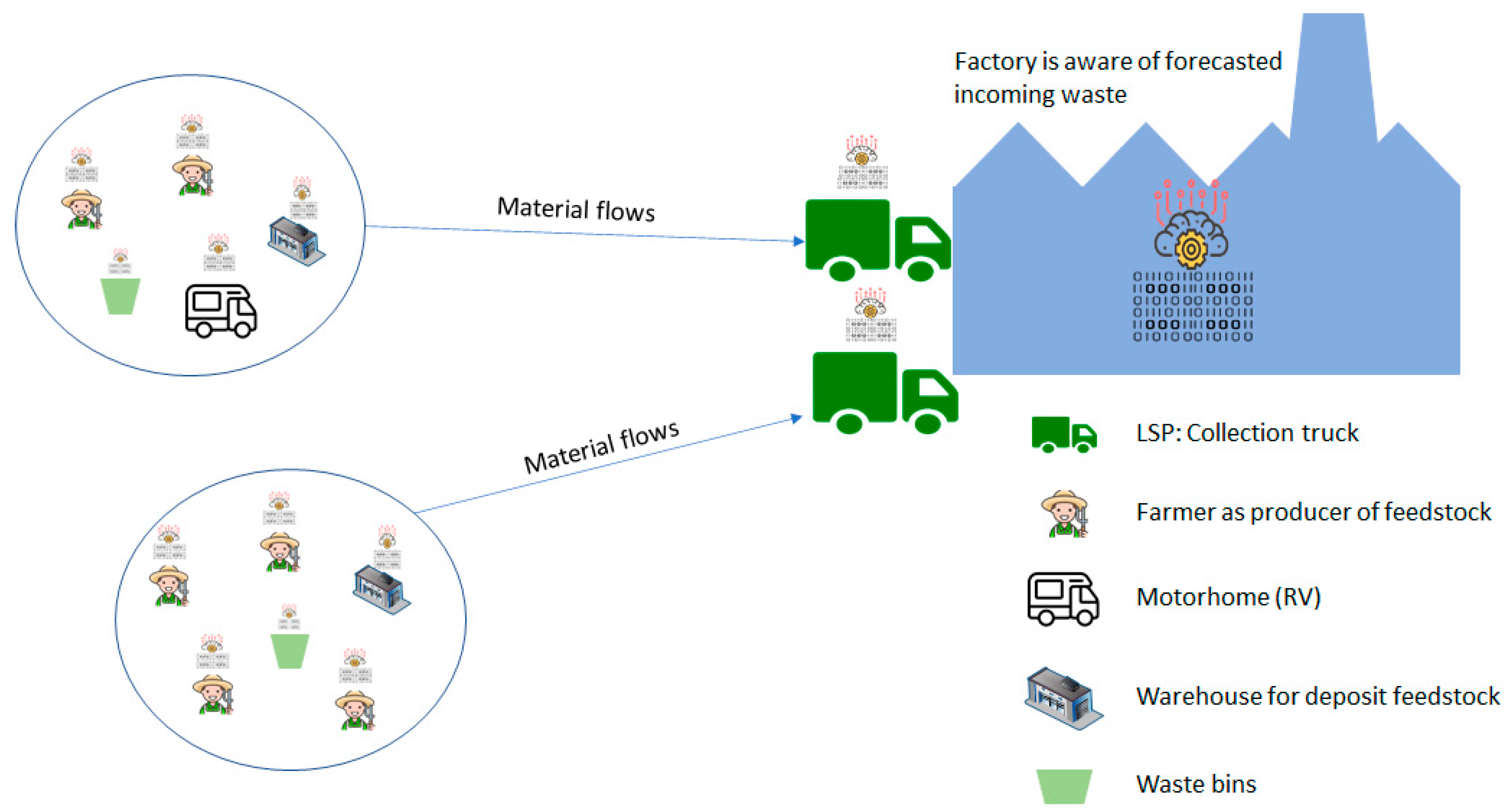
| Stakeholder | Description | Role in Connected Supply Chain |
|---|---|---|
| Factory | Waste processing factory | • Is informed about real-time material flows • Improved handling of incoming materials • Optimized logistics and production planning |
| Farmer | Producer of incoming materials (woods, organic waste, etc.) | Using an app, informs about the availability of materials to be collected |
| Waste bin | Bin where other people can deposit waste | Using a sensing device communicate with the LSP the need for waste to be collected |
| Warehouse | Deposit place where farmers can throw their waste with their own trucks | Informs the LSP about the availability of waste or forwards it to the factory |
| Motorhomes | Moving actors which need to deposit their organic waste into the bins | Using an application, they can identify the nearest waste bin to deposit their waste |
| LSP | Collection and forwarding waste into the factory | Gets notifications from farmers, bins, warehouses, and motorhomes, about the availability of material to be collected |
| CDT | Information Receiver | Liability (Stakeholder) | Autonomy for Decision Making | |||||
|---|---|---|---|---|---|---|---|---|
| Processing Factory | Farmer | Waste Bin | Warehouse | Motorhome | LSP Truck | |||
| Processing factory | - | Factory | Per case | |||||
| Farmer’s waste | Waste to collect | Waste to collect/deposit | Waste to collect | Farmer | Per case | |||
| Waste bin | Waste to collect | Availability and location to deposit the waste | Waste to collect | Owner of waste bin | Automatic | |||
| Warehouse | Waste to collect | Waste to collect | Warehouse owner | Per case | ||||
| Motorhome | Location and waste availability | Motorhome manufacturer/driver | Per case | |||||
| LSP truck | Waste to forward | LSP provider/driver | Per case | |||||
Publisher’s Note: MDPI stays neutral with regard to jurisdictional claims in published maps and institutional affiliations. |
© 2021 by the authors. Licensee MDPI, Basel, Switzerland. This article is an open access article distributed under the terms and conditions of the Creative Commons Attribution (CC BY) license (https://creativecommons.org/licenses/by/4.0/).
Share and Cite
Kalaboukas, K.; Rožanec, J.; Košmerlj, A.; Kiritsis, D.; Arampatzis, G. Implementation of Cognitive Digital Twins in Connected and Agile Supply Networks—An Operational Model. Appl. Sci. 2021, 11, 4103. https://doi.org/10.3390/app11094103
Kalaboukas K, Rožanec J, Košmerlj A, Kiritsis D, Arampatzis G. Implementation of Cognitive Digital Twins in Connected and Agile Supply Networks—An Operational Model. Applied Sciences. 2021; 11(9):4103. https://doi.org/10.3390/app11094103
Chicago/Turabian StyleKalaboukas, Kostas, Joze Rožanec, Aljaž Košmerlj, Dimitris Kiritsis, and George Arampatzis. 2021. "Implementation of Cognitive Digital Twins in Connected and Agile Supply Networks—An Operational Model" Applied Sciences 11, no. 9: 4103. https://doi.org/10.3390/app11094103
APA StyleKalaboukas, K., Rožanec, J., Košmerlj, A., Kiritsis, D., & Arampatzis, G. (2021). Implementation of Cognitive Digital Twins in Connected and Agile Supply Networks—An Operational Model. Applied Sciences, 11(9), 4103. https://doi.org/10.3390/app11094103








